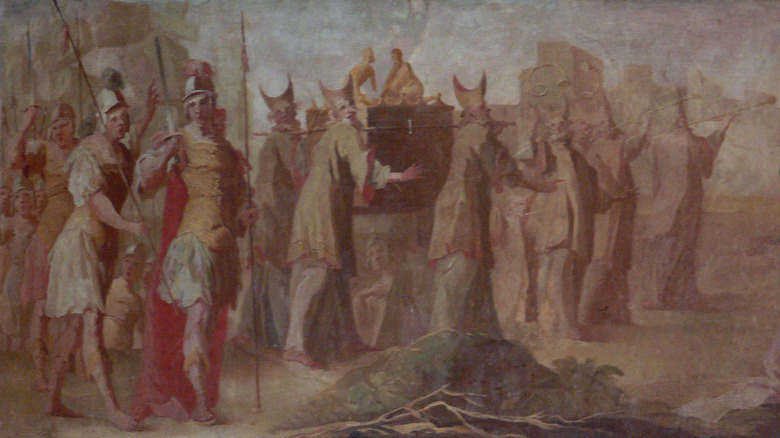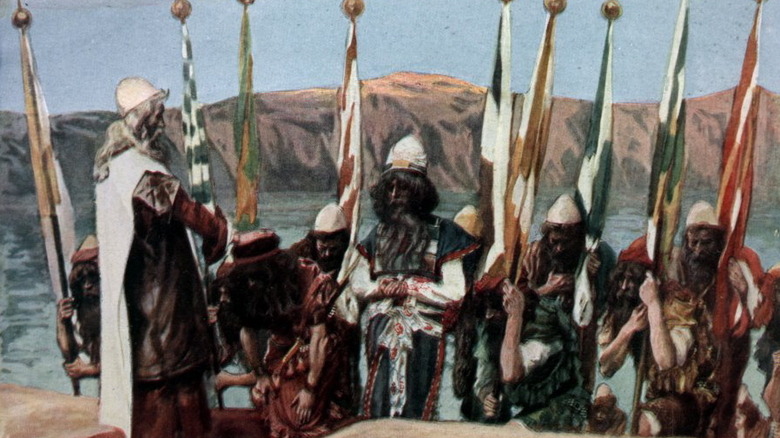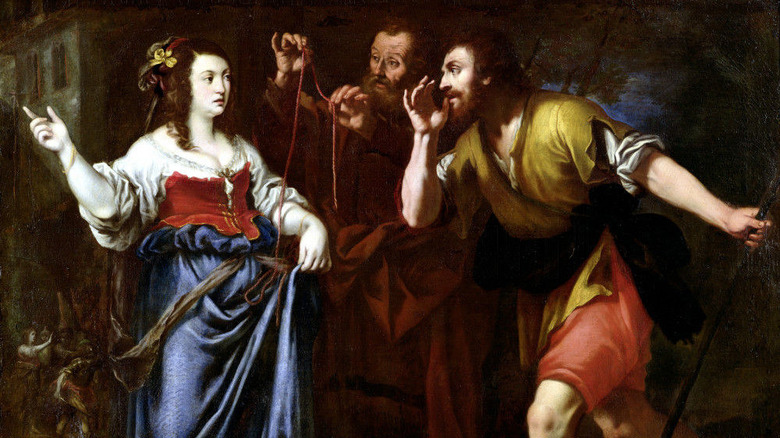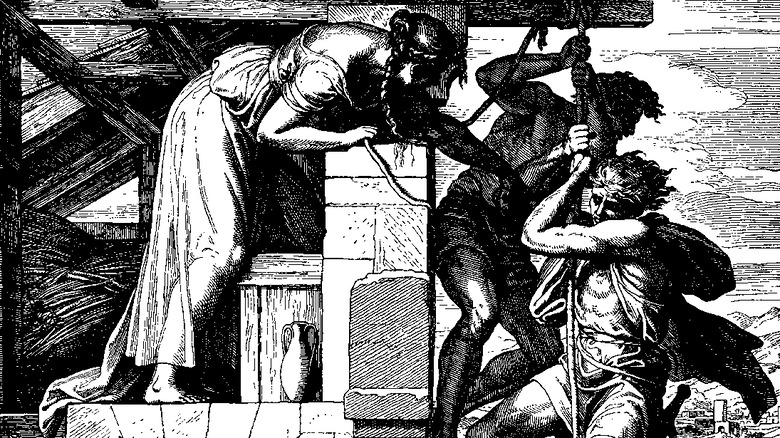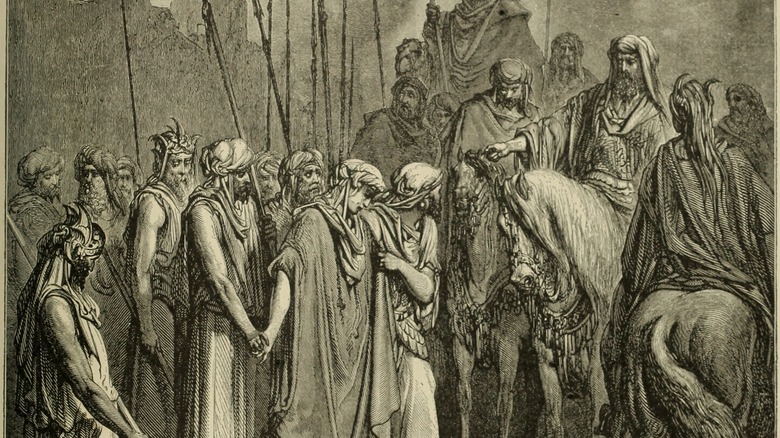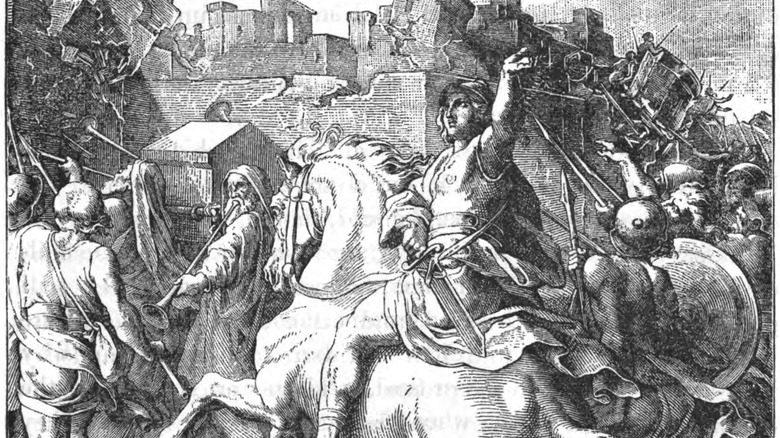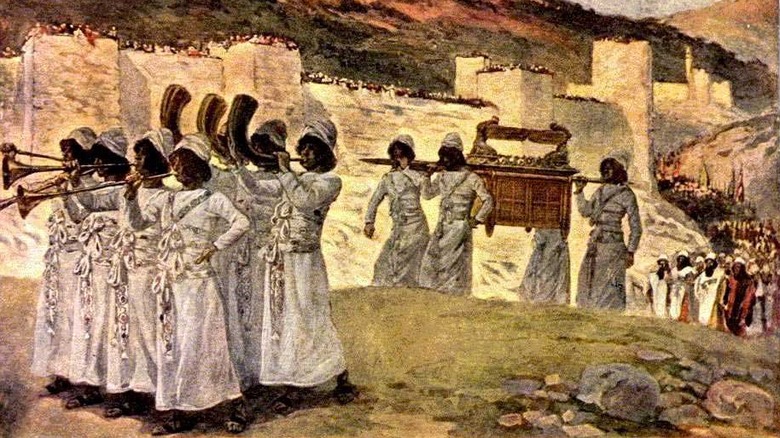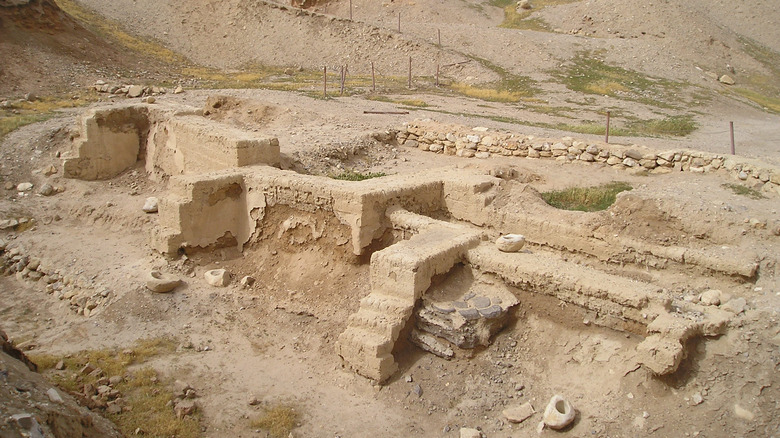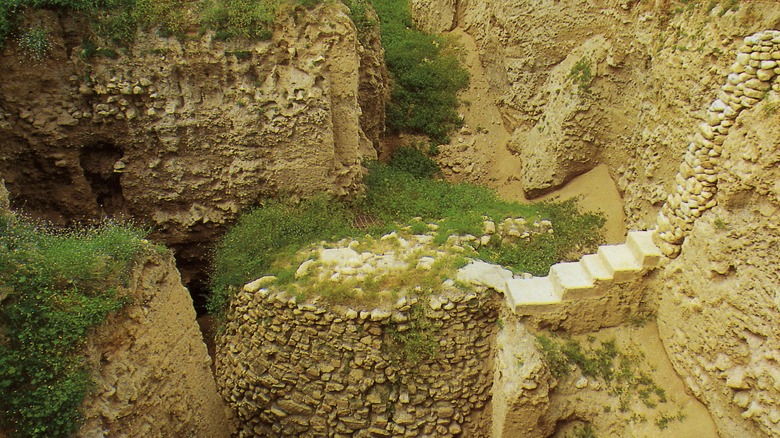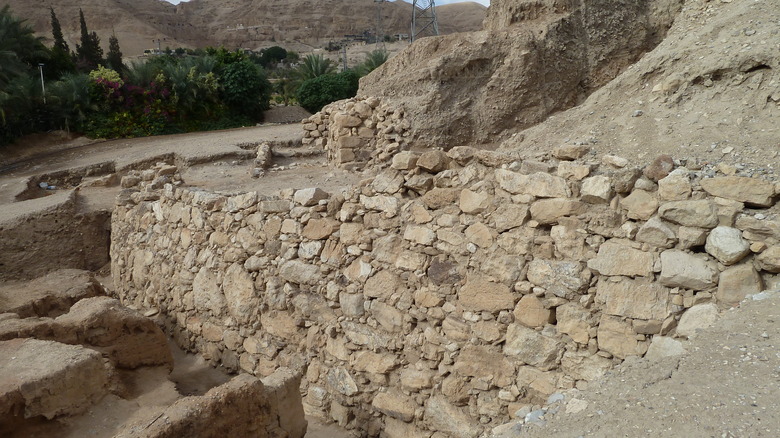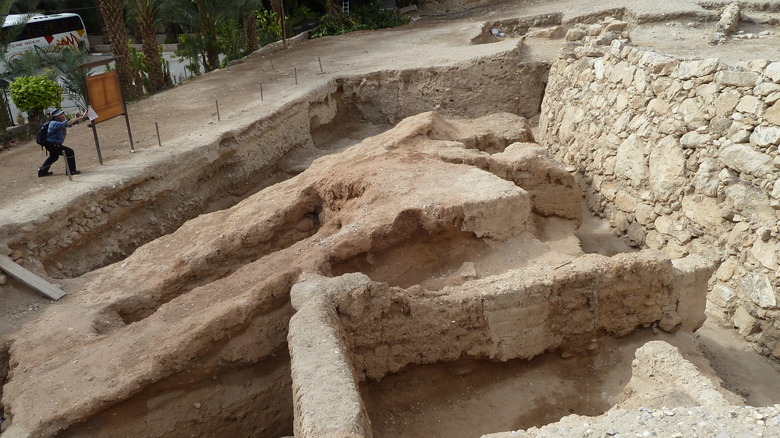What No One Told You About The Fall Of Jericho
According to the Bible, the Israelites escaped centuries of slavery in Egypt through the leadership of Moses and the supernatural powers of the God of the Jews. After this escape, the Israelites spent some time wandering in the desert before being allowed entrance into Canaan, the land that God had promised to their ancestor Abraham before they had left for Egypt. There was only one problem: There were already people living in Canaan. Like, a lot of them. In order for the Israelites to claim the land promised to them by God, they were going to have to fight some Canaanites. Like, a lot of them.
The first battle of the Israelites in Canaan was the Battle of Jericho, a large city with formidable walls. In one of the more famous stories of the Bible, the Israelites, under the leadership of a man named Joshua, won this battle in a most unconventional manner. If all you know about this famous battle is that the walls came tumbling down, strap in to see just how much you don't know.
The miraculous capture of Jericho
The Battle of Jericho is perhaps the most famous incident from the Book of Joshua in the Hebrew Bible. The Israelites' siege and capture of the city is the focus of Chapters 2 through 6 of that book, with the battle itself occurring in Chapter 6. As the Jewish Encyclopedia explains, the Book of Joshua is the first book of the second major division of the Hebrew Bible, that is to say, the portion that follows the books of Moses. As such, it logically follows the exploits of Moses' successor, Joshua, whose job it was to lead the Israelites into the Promised Land after their time in Egypt and wandering the desert. The only problem is that there are already people living in the Promised Land, aka Canaan. The Book of Joshua deals with how the Israelites cleared those people out.
Jericho is the first city that Joshua's forces encounter, and it's a well-fortified one thanks in large part to the famous wall that surrounded it. In the biblical account, the Israelites capture the city in a miraculous manner: They march around the walls with the Ark of the Covenant once a day for six days, and on the seventh they march around the city seven times and on the seventh lap they blow ram's horn trumpets and shout really loud. This tumult causes the walls to crumble to dust and the Israelites massacre (almost) everyone inside.
Joshua, moon to Moses' sun
The main dude of the Book of Joshua is, fittingly, Joshua, son of Nun, the appointed successor of Moses as the leader of the Israelites. As the Jewish Encyclopedia explains, Joshua first appears in the Book of Exodus as the chief of the Ephraimite tribe who leads a small band of Israelite warriors to victory over the Amalekites in their first battle following the exodus from Egypt. Joshua subsequently accompanies Moses in several of his duties, and perhaps most notably is one of the 12 spies that Moses sends into Canaan to scout out their prospects. Joshua and Caleb are the only two spies to give an optimistic report, with the others being terrified of the Canaanites. As a result, Joshua and Caleb are the only two Israelites of their generation allowed to enter the Promised Land.
In Jewish tradition, Joshua is remembered for his bravery, humility, and faithfulness. Rabbinical literature says that, unlike most generals, Joshua always fought on the front lines of his army rather than at the rear. The Bible says that Moses' face shone like the sun due to his constant exposure to the presence of the Lord, and tradition says that Joshua's shone like the moon as a reflection of his faithful service to Moses. Joshua was also said to have had the physical strength of an ox and the beauty of the re'em, an animal sometimes translated as a unicorn.
Joshua's loyal spies
Just as Joshua and his companion Caleb had been sent among a group of spies to scout out Canaan, so did Joshua send spies to get information on Jericho prior to the Israelite siege of that city. As Chabad explains, the biblical account tells us that Joshua sent two spies into the city to evaluate the mood of the people of Jericho ahead of the siege, and also to learn the layout of the city. While the Book of Joshua does not name the two spies, rabbinic tradition says that the two spies were Caleb, the other faithful scout who had accompanied Joshua before, and Pinchas, a zealous Israelite who had previously saved his people from a plague by slaying the tribal leader whose impious actions had brought the curse upon them.
The spies, whatever their names might have been, found shelter in the home of a woman named Rahab, traditionally identified as a sex worker. While the Bible doesn't explain why the spies chose such a place as their hideout, Jewish tradition gives two reasons: First, Rahab's work meant that she was commonly in contact with the local aristocracy, but also -– since Jews were famously forbidden from promiscuity — it would seem less likely that the two strangers were Jews. Rahab's heroic aid to the Israelite spies meant that she and her family were the only citizens of Jericho to survive Joshua's siege.
A sex worker was the key to victory
Rahab did more than just provide shelter for the Jewish spies. Joshua Chapter 2 tells how she hid the spies from the king's soldiers under stalks of flax and sent the soldiers on a wild goose chase looking for the strangers. As Chabad explains, however, grammatically the biblical account says she only hid one man, so some rabbis explained this by saying that Pinchas, being of the priestly tribe, was so spiritual that he had the angelic ability to become invisible. Either way, the conquest of Jericho couldn't have happened without Rahab, and she is fondly remembered in Jewish tradition as a result.
The Jewish Encyclopedia says that Rahab was remembered as one of the four most beautiful women who ever lived, with the other three being Abraham's wife Sarah, David's wife Abigail, and Queen Esther. In fact, Rahab was said to be so beautiful that the mere mention of her name could cause sexual arousal. Rahab was so well thought of that several commentators refused to believe that she was actually a sex worker, and interpreted the word used in the text to mean someone who owns a restaurant. Many commentaries, however, including those in the Talmud, accept that Rahab was a sex worker but believe that after the fall of Jericho she became a full and sincere convert to the worship of the God of the Jews.
The famous descendants of Rahab
In the account recorded in the Book of Joshua, following the conquest of Jericho, Joshua continued to lead his army to victory around the Promised Land, and soon was allotting districts in the land to the various tribes of Israel. No mention is made of him ever having a wife or family, only that he died at the age of 110. Fortunately for those who care about the personal lives of biblical heroes, Jewish tradition fills in some of those blanks. As the Jewish Encyclopedia explains, the story goes that after the Battle of Jericho, Joshua and Rahab got married. Together they had several daughters but no sons. Nevertheless, their line would go on to produce eight prophet-priests, including the major prophets Jeremiah and Ezekiel.
The authors of the Christian New Testament also regarded Rahab as a positive example. The Epistle to the Hebrews names her as a person of faith and peace, while the Epistle of James gives her name as an example of someone who was justified by their good works. The name Rahab also appears in the Gospel of Matthew. This Rahab didn't marry Joshua, but a Judahite named Salmon and had a son named Boaz. If this Rahab is the same as the one in the Book of Joshua, that means a fearless and faithful sex worker was the ancestor of Jesus.
Joshua cursed the ground of Jericho
The Bible tells us in Joshua Chapter 6 that Joshua carried out God's plan of having the army and priests circle the city walls for seven days before blowing the trumpets that caused the walls to crumble. Once the city's defenses were down, the Israelite army charged in and put every man, woman, child, and animal in Jericho to the sword. The only survivors were Rahab and her family, whose home had been marked for safety by a red cord tied to the window.
A total massacre wasn't the end of it though. Joshua wanted to make sure that this great city didn't rise up again to challenge the Israelites who were newly coming to inhabit the land. As the Jewish Encyclopedia says, all vessels of gold, silver, copper, and iron were looted and dedicated to the Lord. The city and everything else in it were burned to the ground. To make things even more secure for him, Joshua issued a curse on anyone who tried to rebuild the city of Jericho, saying that anyone who tried to rebuild its walls would see the death of his children. And according to the Bible, this curse wasn't a bluff: The First Book of Kings, which takes place many generations later, says a man named Hiel rebuilt Jericho's foundations and gates only for his sons Abiram and Segub to be struck dead by the power of the curse.
The lesson of Jericho
What, then, is the lesson we are meant to take from the story of Joshua's conquest of Jericho? Chabad tells us that the message of the story is that of God's overall plan: Transform a dark and lawless place into a dwelling for God and his worship. The Israelite spies sent into the Canaanite city are a metaphor for the soul, a divine element, being sent down into a physical body, a human element. Just as Joshua and his spies drove out the ungodly people and temples of Jericho, so should the divine soul turn its human meatbag into something appropriate for God. The two spies -– Pinchas, of the priestly Levite tribe, and Caleb, of the non-priestly Judahites -– represent the soul and body working together toward a harmony of divine and human elements that will be finalized by the arrival of the Moshiach (Messiah).
From a Christian perspective, Got Questions tells us that Joshua's unorthodox victory using marching and the sound of trumpets shows how faith in God's commands, no matter how strange on the surface, can accomplish the seemingly impossible. God's plans and humanity's plans are often at cross purposes, but the story shows that God's way is the way. Likewise, God's power is beyond human comprehension, but he will always keep his promises to those who are faithful and obedient to him. However, as the Epistle of James says, faith must be backed up with action.
The historical Jericho
We don't need to rely solely on the biblical accounts of Jericho and its fall, however. Archeological evidence shows us that there was in fact an ancient city surrounded by a network of walls in that area. As the World History Encyclopedia explains, the site now known as Tell es-Sultan (Sultan's Hill), just north of the modern-day city of Jericho in the West Bank, has been identified as the location of ancient Jericho, which was likely one of the earliest cities in human history. The site originated as a popular spot for hunter-gatherers to camp, going back as far as 10000 B.C., with a nearby spring serving as a convenient water source. This Neolithic community grew to include more than 70 homes made of clay and straw, standing some 16 feet in diameter. A second Neolithic community later settled there around 7000 B.C., whose most notable characteristic was keeping the skulls of dead relatives with their faces painted on them.
The Canaanites whom Joshua and his army would have encountered didn't take over the site of Jericho until around 1900 B.C., reaching the height of their power sometime between 1700 and 1550 B.C., according to the World History Encyclopedia. At this time, the use of chariots by an aristocratic culture to the north of Jericho led to an increase in urbanization in the area, including Jericho itself.
Jericho builds its famous walls
Of course, the most famous detail about ancient Jericho is the walls that Joshua and the Israelites were able to supernaturally topple with nothing more than faith and loud noise. It probably won't surprise you to learn that Jericho, as an ancient urban area, did in fact have a system of walls around it, as most large cities did. According to the World History Encyclopedia, the earliest walls surrounding the city of Jericho were erected in the Neolithic Era, around 8000 B.C.. This was a stone wall about 12 feet tall and about 6 feet thick at the base. This wall enclosed an area of about 430,000 square feet, and included a tower with 22 steps inside it. This is one of the oldest towers ever discovered, with only structures in nearby Syria recognized as older.
While you might assume that a town surrounds itself with walls for protection from outside invaders, archeologists believe instead that Jericho's first walls were built to protect the city from floodwaters rather than armies. The tower, rather than being a lookout, was apparently used for ceremonial purposes, to help encourage a communal lifestyle during a time when the idea of "society" was still being invented. These stone walls lasted until the Neolithic societies of Jericho abandoned the site around 6000 B.C.
The story was probably propaganda
While a skeptical person might reasonably assume that the ancient city of Jericho was not supernaturally toppled by God's favored army when they played the trumpet real loud, you might still allow for the idea that the Israelites did actually besiege and conquer the city as part of their conquest of Canaan. However, the composition of the Book of Joshua came long after the events it describes. According to the Encyclopedia Britannica, the Book of Joshua was written -– or at least edited into the form we now recognize as the Book of Joshua -– during the Babylonian Exile of the people of Judah, around 550 B.C. The section telling the story of the Battle of Jericho likely dates to no earlier than 722 B.C., when the northern kingdom of Israel was conquered by the Assyrians, centuries after the events of the Book of Joshua.
The story of Joshua and the Battle of Jericho could be essentially a piece of nationalist propaganda, used to bolster support for the southern kingdom of Judah's claim over the recently-conquered northern kingdom. The compiled version of the Book of Joshua from 500 B.C., with its message that the Promised Land was delivered to the Jews by God, would have served as a great comfort to the exiled Judeans as a promise of the restoration of glory to Israel and Judah.
The walls did really fall, though
Taking the scholarly, non-biblical, view that Joshua probably did not in fact lead an army against Jericho -– or as the Encyclopedia Britannica says, that the Bronze Age Israelites were more likely interested in survival rather than fighting, and indeed originated in Canaan rather than marching in from Egypt -– it might be easy to conclude that every aspect of the story is made up whole cloth. However, there is archeological evidence that the mighty walls of Jericho did in fact fall. As the World History Encyclopedia says, about 1,000 years of sitting uninhabited after being abandoned by the second Neolithic community, Jericho became a walled city again by the fourth millennium B.C., and over the years these walls were built up and rebuilt many times. By the Bronze Age, the city was surrounded by two walls made of mud brick, with the outer wall resting on a base of stone.
Though large, these walls were far from stable. Sometime around 1573 B.C., Jericho's system of walls were toppled by an earthquake. Remains suggest that the city was burned afterwards, but underground food supplies suggest that no siege had taken place. Scholars who believe the biblical account point to this as evidence of the truth of the story in Joshua, but mainstream scholars point out that the date of the walls' collapse is still hundreds of years distant from the biblical account.
The famous song was about the end of slavery
Besides the biblical version of the story, the most famous telling of the story of Joshua and Jericho is almost certainly the African-American spiritual "Joshua Fit the Battle of Jericho," with its well-known refrain of, "the walls came tumbling down." The lyrics of the song recount the events more or less as they are related in the Bible, with the trumpets sounding, the people shouting, and the walls tumbling down. According to the Tabernacle Choir, the song is believed to have been originally composed by enslaved African-Americans in the early 19th century before being recorded for the first time in 1922 by Harrod's Jubilee Singers. The song would go on to be recorded by a number of notable artists, including Mahalia Jackson, Paul Robeson, Bing Crosby, Elvis Presley, and Dr. House himself, Hugh Laurie.
Some versions of the song render the lyrics in more dialect than others ("de Battle ob Jericho," for example), but most well-known versions maintain the use of "fit" for "fought" in the title. Many African-American spirituals contained an allegorical element referencing hope (or even explicit instructions) for freedom from slavery, and it's not hard to see this song's refrain of "the walls came tumbling down" as a powerful promise of liberation. The bouncy, energetic tune likely served as a source of reassurance and inspiration as well.
